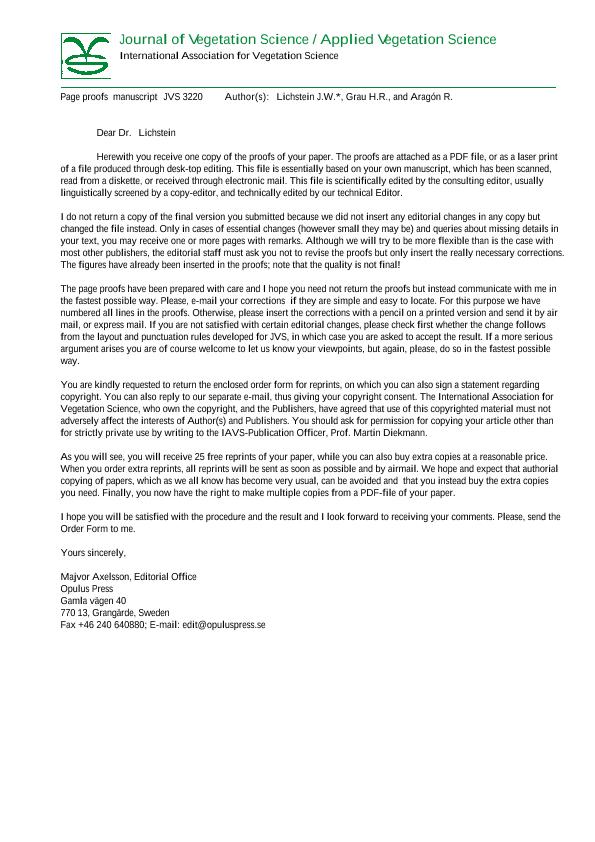Mostrar el registro sencillo del ítem
dc.contributor.author
Lichstein, Jeremy W.
dc.contributor.author
Grau, Hector Ricardo

dc.contributor.author
Aragón, Myriam Roxana

dc.date.available
2020-05-21T14:46:10Z
dc.date.issued
2004-12
dc.identifier.citation
Lichstein, Jeremy W.; Grau, Hector Ricardo; Aragón, Myriam Roxana; Recruitment limitation in secondary forests dominated by an exotic tree; Wiley Blackwell Publishing, Inc; Journal of Vegetation Science; 15; 6; 12-2004; 721-728
dc.identifier.issn
1100-9233
dc.identifier.uri
http://hdl.handle.net/11336/105670
dc.description.abstract
Question- What factors limit woody plant recruitment in a mosaic landscape where former agricultural lands are dominated by the invasive tree, Ligustrum lucidum W. T. Aiton (Oleaceae)? Location- Subtropical northwestern Argentina. Methods- In secondary forest patches, we measured (1) tree, shrub, and liana abundance in different size classes (stems ¡Ý 25 cm tall); (2) seed rain of Ligustrum and two native trees; and (3) topographic, soil, and light variables. We used spatial autoregressive models to test for effects of Ligustrum canopy dominance and environmental variables on native plant abundance in each size class. We used multiple regression on resemblance matrices to quantify the relative importance of spatial (e.g., dispersal) and environmental effects on native species composition. Results- Native tree abundance in the smallest size class was unrelated to Ligustrum canopy dominance, while native tree abundance in larger size classes and native liana abundance were negatively correlated with Ligustrum dominance. Native species composition was both environmentally and spatially structured, suggesting that some species are dispersal limited. Seed rain was spatially correlated with conspecific basal area for one of two native species, but not for Ligustrum. Conclusions- Native tree recruitment appears to be limited primarily by sapling mortality in patches dominated by the invasive Ligustrum. Ligustrum does not appear to be dispersal limited in our study area and is likely to continue spreading. Invaded patches may persist for hundreds of years
dc.format
application/pdf
dc.language.iso
eng
dc.publisher
Wiley Blackwell Publishing, Inc

dc.rights
info:eu-repo/semantics/openAccess
dc.rights.uri
https://creativecommons.org/licenses/by-nc-sa/2.5/ar/
dc.subject
Subtropical northwestern Argentina.
dc.subject
Ligustrum lucidum
dc.subject
Native tree recruitment
dc.subject
sapling mortality
dc.subject.classification
Ecología

dc.subject.classification
Ciencias Biológicas

dc.subject.classification
CIENCIAS NATURALES Y EXACTAS

dc.title
Recruitment limitation in secondary forests dominated by an exotic tree
dc.type
info:eu-repo/semantics/article
dc.type
info:ar-repo/semantics/artículo
dc.type
info:eu-repo/semantics/publishedVersion
dc.date.updated
2020-03-30T14:34:59Z
dc.journal.volume
15
dc.journal.number
6
dc.journal.pagination
721-728
dc.journal.pais
Reino Unido

dc.journal.ciudad
London
dc.description.fil
Fil: Lichstein, Jeremy W.. University of Princeton; Estados Unidos
dc.description.fil
Fil: Grau, Hector Ricardo. Universidad Nacional de Tucumán. Facultad de Ciencias Naturales e Instituto Miguel Lillo. Laboratorio de Investigaciones Ecológicas de las Yungas; Argentina. Consejo Nacional de Investigaciones Científicas y Técnicas. Centro Científico Tecnológico Conicet - Tucumán; Argentina
dc.description.fil
Fil: Aragón, Myriam Roxana. Universidad Nacional de Tucumán. Instituto de Ecología Regional. Consejo Nacional de Investigaciones Científicas y Técnicas. Centro Científico Tecnológico Conicet - Tucumán. Instituto de Ecología Regional; Argentina. Consejo Nacional de Investigaciones Científicas y Técnicas. Oficina de Coordinación Administrativa Parque Centenario. Instituto de Investigaciones Fisiológicas y Ecológicas Vinculadas a la Agricultura. Universidad de Buenos Aires. Facultad de Agronomía. Instituto de Investigaciones Fisiológicas y Ecológicas Vinculadas a la Agricultura; Argentina. Universidad Nacional de Tucumán. Facultad de Ciencias Naturales e Instituto Miguel Lillo. Laboratorio de Investigaciones Ecológicas de las Yungas; Argentina
dc.journal.title
Journal of Vegetation Science

dc.relation.alternativeid
info:eu-repo/semantics/altIdentifier/doi/https://doi.org/10.1111/j.1654-1103.2004.tb02314.x
dc.relation.alternativeid
info:eu-repo/semantics/altIdentifier/url/https://onlinelibrary.wiley.com/doi/abs/10.1111/j.1654-1103.2004.tb02314.x
Archivos asociados
